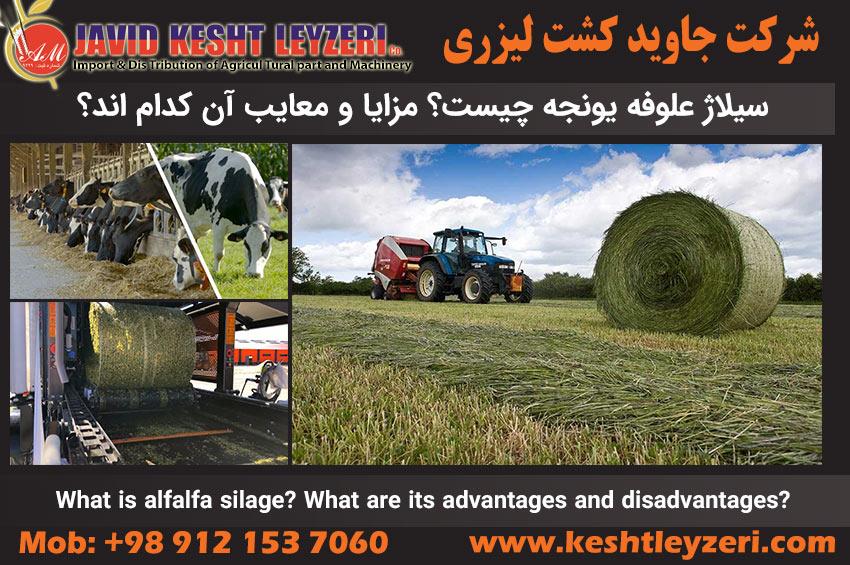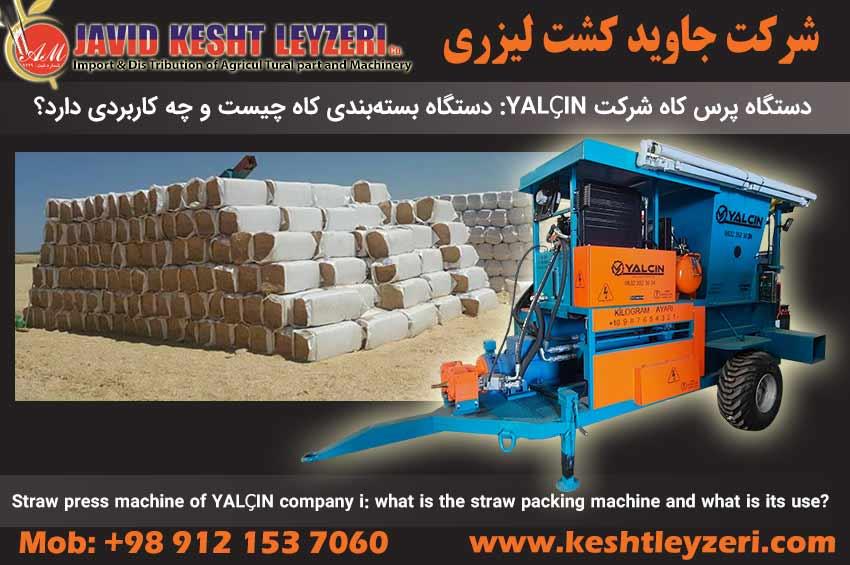
Hay silage forage
javid keshtleyzeri Co.ltd
Rye hay can be converted into a high protein silage crop. But making high-quality alfalfa silage is much more difficult than fodder corn silage; Because protein is one of the first substances that will break down if the silage process is not performed properly.
This problem can be solved by mixing corn or sorghum with hay during silage stacking.
The amount of moisture for silage should be between 60% and 70%. If porous silage is available, haylage (40% to 60% moisture) can be prepared, which is of very high quality.
What is hay silage?
Hay silage is a hay silage product that can be used for livestock and poultry. Silage hay is used for the reason that the loss of material quality is prevented in the long term and it is possible to use fresh and suitable fodder for livestock and poultry. In addition to the fact that silage does not lose its quality and freshness in the long term, silage also contains other minerals and nutrients that are useful for livestock and poultry and make them more productive. Silage and all types of fodder are made in three ways: horizontal, stacked and vertical, using plastic. Also, the necessary and suitable humidity for silage is between 65 and 70 percent.
Hay silage
Alfalfa and other perennial glume plants are important forage crops because they are able to produce a large amount of good quality forage, and no other family of forage crops provides a better balance of energy, protein and minerals for livestock. They are not productive.
In recent years, especially when high rainfall limits the opportunity to produce dry fodder, ensiling has become a common conservation method.
In some cattle farms that grow alfalfa, they usually use fresh alfalfa, which is done in the first layer of alfalfa. In terms of high humidity, alfalfa has more risks of reducing magnesium in the blood and the occurrence of grass tetani, as well as rapid changes in the microbial flora of the rumen. Especially in high-producing cows, it will cause metabolic problems. In addition, dry alfalfa has very low protein in terms of leaf shedding and significant shedding in the field and during transportation. Alfalfa silage is an exception to these cases. In addition, its quality will be much higher and better than fresh raw alfalfa in terms of maintaining nutrients and increasing digestibility. Ensiling alfalfa should be done by withering and reducing its moisture after harvesting and before ensiling. which is an easy method.
Hay silage can be stored in a polyethylene bag for up to 15 months without significant loss. It goes without saying that the life of silage depends on the technology and structure of the silage bagger and stretch film (plastic).
What are the advantages and disadvantages of alfalfa silage in animal feed?
Are you familiar with its advantages and disadvantages in animal feed? How is the nutritional value and price of this product compared to corn silage and dry alfalfa?
The queen of fodder plants, Medicago sativa or alfalfa is a product that is cultivated in most regions of the world. According to the experiments, about 26-54% of the nutritional value and dry matter of alfalfa changes from the time of harvesting to consumption.
Hay or fodder silage, which is one of the not so new ways of increasing the productivity of hay and fodder, has many advantages. These advantages have come to the aid of people who are active in livestock and poultry industries and fields and have livestock farms, etc., and help to get more profit from livestock and poultry and thus increase their income. For this reason, today all over the world and in Iran, fodder and alfalfa silage and silage products in general are widely used in livestock and poultry breeding.
What are the benefits of hay silage?
Energy saving.
The ability to irrigate the land the day after the hay is laid.
Preventing the loss of about 10% of hay that occurs in the hay drying method.
The higher percentage of protein in silage hay compared to dry hay.
Increasing the appetite of livestock and poultry.
Retention of carbohydrates and nutrients that are lost due to hay drying.
Reduction of waste compared to hay bale drying.
Increasing milk and protein production in livestock.
It is simpler and easier to transport and store it in the warehouse.
Higher durability and longer shelf life by preserving all the minerals and nutrients of alfalfa.
What are the benefits of hay silage in polyethylene bags?
Long-term storage of green mass of alfalfa by maintaining its freshness
Prevent hay quality loss
Better balance of rations
Ease of transportation, storage and storage
The economics of hay silage production
Control the size of parts
Increase fiber digestibility
Recommendation: By adding fermentation accelerators such as lactobacilli and the like, the work of ensiling in polyethylene bags can be improved.
What can be done to prevent the loss of hay dry matter?
Silage is one of the ways to prevent material loss. Storage and preservation in this way is done according to the creation of anaerobic conditions in pH, which is the result of biochemical, microbiological and anaerobic fermentation processes. The buffering capacity of fodder and the ability to consume fermentable substances determine the fermentation rate.
What is hay silage in the diet of dairy cows?
Valadars et al. (2000) showed in their research on dairy cows that all the forage can be obtained from alfalfa silage. The combination ratio of 35% alfalfa silage and 65% concentrate showed the highest production of milk, lactose, protein and milk solids.
Also, Cross and Kamp (2003) in a research showed that consumption of alfalfa silage in dairy cows has a positive effect on milk fat and protein.
The protein ratio of alfalfa silage and corn silage is 13 to 19.2 percent. Meanwhile, corn silage has 8.8% protein. Hay, both dry and silage, includes approximately 25% of the ration of dairy cows. Today, in the United States, alfalfa is used in mixed rations with feeders, and its dry form is not used.
Saving energy carriers by using hay silage
Several necessary operations are carried out in the dry hay harvesting stage, which are:
Picking and pouring the device on the ground, arranging the arranged hay, turning the arranged hay upside down and finally pressing and packing them.
It is known that doing this operation requires a lot of energy and takes about 7 to 10 days. With a rough calculation, it is clear that in a crop year, the agricultural land remains without irrigation for about 30 to 40 days, and this itself causes a decrease in yield.
The discussion of energy carriers in Iran is quite visible in the production of dry fodder and has affected the price of dry hay and raised it a lot.
In the operation of picking hay for the purpose of producing silage, we do not see the mentioned cases, and like the production of corn silage, the hay is transported by truck or trailer after being crushed, and the land can be irrigated from the next day.
In this method, less energy is needed for harvesting, and this will reduce costs and increase the number of bales of hay.
Another advantage of harvesting alfalfa for silage is preventing alfalfa leaves from falling, which is lost in the drying process by about 2 to 10%.
Hay silage protein
Silage increases the protein content of hay compared to its dry weight. This causes the cost price of hay silage to decrease compared to other protein sources.
Among the advantages of hay silage is its positive effect on increasing the animal's appetite, which is evident especially in dairy cows from the very first days of use.
What is the protein ratio of hay silage and corn silage?
Crude protein in alfalfa silage and dry alfalfa fodder is 13-19.2%, while corn fodder silage has 8.8% protein. Hay, either dry or silage, comprises approximately 25% of the ration of dairy cows. The United States uses alfalfa in food rations as a mixture and with the Feeder machine in its programs and does not use its dry form.
Advantages of corn silage
The type of harvest and the way of storing fodder affects the nutritional value of wood materials. The forages that are laid for drying are bleached due to indifference to the sunlight, and dew and rain cause the loss of some of the soluble carbohydrates and nitrogen. Also, most of the leaves are lost in transportation.
In general, the waste of dry matter in the artificial drying method is about 6% and in the field drying and packing method is about 33%, while in the silage method, the waste is reduced.
Silage products are very palatable and are consumed very well and have a great positive effect, especially in productive animals.
How is the production of hay silage?
Hay silage protein is high and its cation-anion difference is high. The percentage of soluble carbohydrates is low, which prevents the rapid lowering of pH. Therefore, in the production of this product, one should know the method of preparation, its advantages and disadvantages and its long-term strategies.
The production of hay silage requires a strong scientific support and mechanization should be used for this operation. Fortunately, this collection has succeeded in producing the highest quality and best type of packaged hay silage.
Do you know the results of research on the nutritional effect of hay silage in animal feed? Is the use of this product effective in milk production of dairy cows?
With the production of a new product, it is very important for livestock farms to know what effect the consumption of this product has on their livestock. What are the advantages and disadvantages of this product and does this product have any adverse effects on their livestock?
Research results on alfalfa silage
1. Hoffman et al. in 1997 investigated the effect of hay silage on dairy cows. They showed that the use of alfalfa silage increases milk production and increases milk fat percentage.
2. In 1997, Damon and Sutter investigated different proportions of corn silage and alfalfa silage on dairy cows. The results of this research indicated that consuming two-thirds of alfalfa silage and one-third of corn silage has a positive role in increasing milk and fat production.
3. In 1997 Broderick et al also conducted another research on hay silage. This research showed that ensiling hay with high humidity reduces the non-protein nitrogen form and reduces the degradability of microbial protein in the rumen. The results of this research indicated the improvement of milk production in dairy cows.
4. Research on the effect of alfalfa silage on dairy cows was also conducted in 2010, and Rong Yan et al. showed that increasing the consumption of alfalfa silage increases milk production, milk linoleic acid and milk protein.
5. Broderick and Rudolph in 2004 investigated the effect of adding dry molasses to alfalfa and corn silage, and this research shows an increase in dry matter consumption, an increase in milk production, an increase in fat, an improvement in the digestibility coefficient and a decrease in rumen ammonia.
6. Another research was conducted in Iran by Vakili et al. in 2008, which showed that the consumption of alfalfa silage had no side effects on the physiological health of the animal, and the use of hydrochloric acid as a cheap and mineral acid enriched the alfalfa silage and affected On chemical properties, it causes the decomposition of dry matter.
Does hay silage cause bloating?
Regarding the bloating of wet hay, there is a question whether hay silage also causes bloating due to being wet or not. In answer to this question, it should be said that there is a risk of bloat with wet fodder when this fodder is consumed fresh in the field. Regarding alfalfa silage, because the moisture content in the production reaches 65% from 85% and more importantly, alfalfa ferments and withers, there is no need to worry about bloating.
Another point worth mentioning is that if you have a history of using other silages such as corn fodder silage, there is no need to worry about using other silages for livestock.
Desire of livestock to consume silage
It is natural that if the animal has not consumed silage before, it will be reluctant to eat it and avoid it. As a rule, the animal must get used to eating silage, which is called a period of ten to twenty days of silage consumption. After this period, livestock consumption will be balanced.






